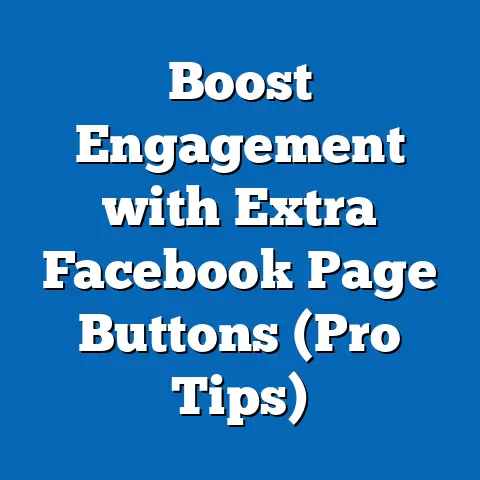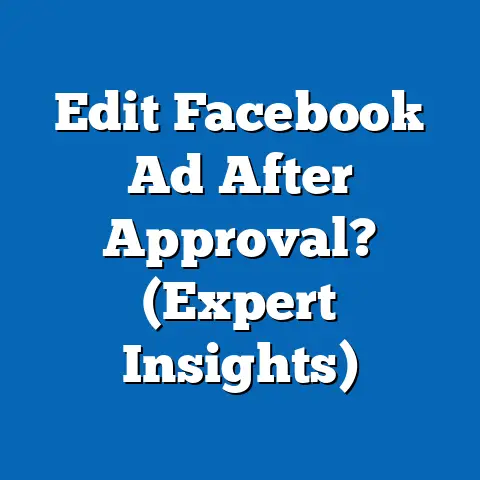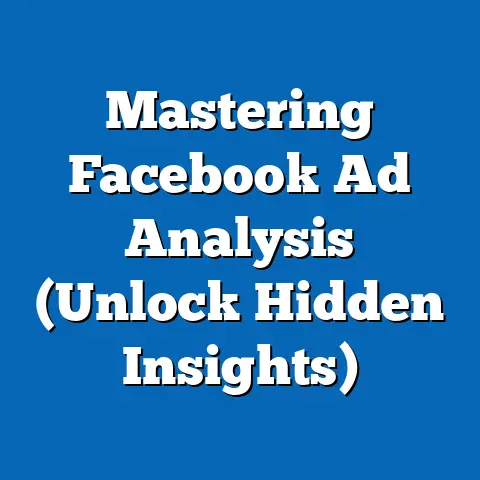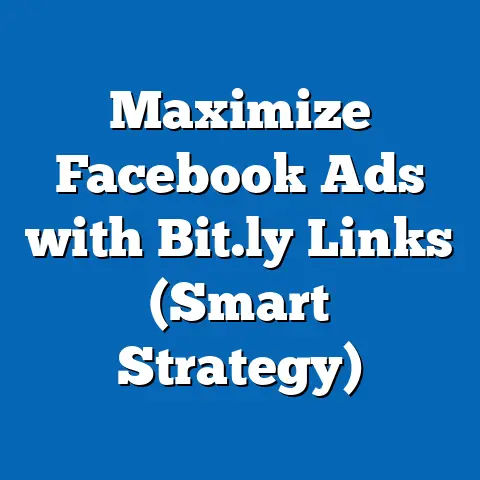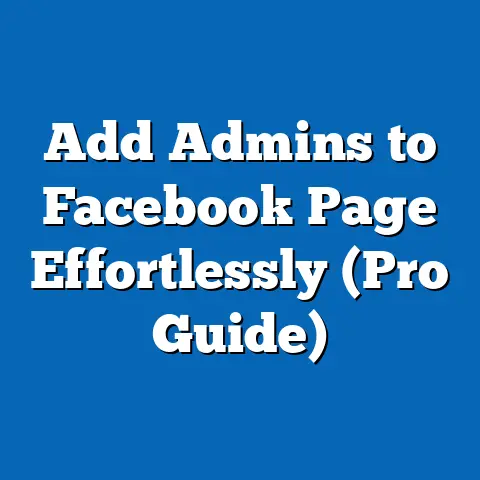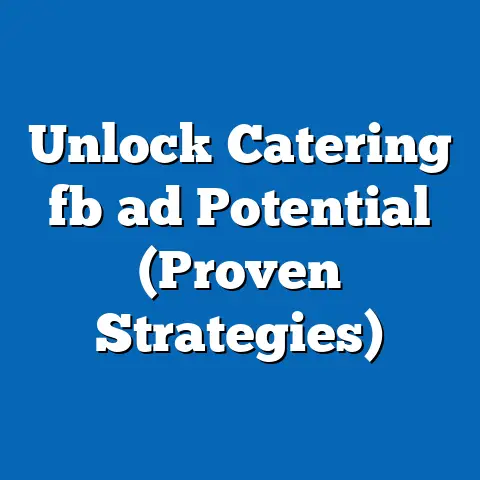Boost ROI with Facebook Target Ads (Expert Strategies)
In the rapidly evolving digital marketplace, businesses face a daunting dilemma: how to maximize their return on investment (ROI) while navigating the complexities of online advertising. With millions of advertisers vying for attention on platforms like Facebook, merely creating ads is not enough. I’ve seen countless companies left grappling with ineffective campaigns, wasted budgets, and disappointing results. The challenge lies not only in targeting the right audience but also in understanding the nuances of Facebook’s advertising algorithm and leveraging it to drive sales. It’s like trying to hit a moving target in the dark – without the right strategy, you’re shooting blanks.
As you delve into this article, we will explore expert strategies that can help boost ROI through Facebook Target Ads. This piece will cover the fundamental aspects of Facebook advertising, advanced targeting techniques, creative ad strategies, and the importance of data analysis—all aimed at equipping you with the tools necessary to overcome the common pitfalls of online advertising. My goal is to illuminate the path, providing actionable insights you can implement immediately.
Understanding Facebook Ads: An Overview
Facebook Ads have become an indispensable component of digital marketing for businesses of all sizes. They offer unparalleled reach and precision targeting capabilities, making them a powerful tool for driving brand awareness, generating leads, and increasing sales.
Definition and Importance of Facebook Ads in Digital Marketing
Facebook Ads are advertisements displayed on Facebook and its associated platforms, such as Instagram, Messenger, and Audience Network. These ads can take various forms, including images, videos, carousels, and lead generation forms. Their importance in digital marketing stems from their ability to target specific demographics, interests, and behaviors, allowing businesses to reach their ideal customers with tailored messaging.
I remember when Facebook ads were just starting to gain traction. Many businesses were skeptical, unsure if they could truly deliver results. But as targeting options became more sophisticated and the platform continued to grow, it became clear that Facebook Ads were not just a trend but a fundamental part of any comprehensive digital marketing strategy.
Brief Statistics on Facebook’s User Base and Advertising Potential
Facebook boasts over 2.9 billion monthly active users as of early 2024, making it the most popular social media platform worldwide. This massive user base presents a vast opportunity for advertisers to reach a diverse range of potential customers. According to Statista, Facebook’s advertising revenue reached nearly $117 billion in 2023, highlighting the platform’s significance in the advertising landscape.
These statistics underscore the immense advertising potential that Facebook offers. With such a large and engaged audience, businesses can significantly expand their reach and drive meaningful results through targeted ad campaigns.
Overview of the Advertising Formats Available on Facebook
Facebook offers a wide range of advertising formats to suit different marketing objectives and target audiences. Some of the most popular formats include:
- Image Ads: Simple and effective, image ads feature a single image with accompanying text.
- Video Ads: Highly engaging, video ads capture attention and convey complex messages in a dynamic format.
- Carousel Ads: Allow users to scroll through multiple images or videos, showcasing different products or features.
- Collection Ads: Designed for e-commerce, collection ads display a catalog of products with a focus on visual appeal.
- Lead Generation Ads: Capture leads directly on Facebook with pre-filled forms, making it easy for users to express interest.
- Instant Experience Ads: Full-screen, mobile-optimized ads that provide an immersive experience for users.
Each of these formats has its strengths and weaknesses, and the best choice depends on your specific marketing goals and target audience. I’ve found that experimenting with different formats and A/B testing is crucial to identify what resonates most with your audience.
Takeaway: Facebook Ads are a powerful tool for digital marketing, offering unparalleled reach and targeting capabilities. Understanding the different advertising formats available and their respective strengths is essential for creating effective campaigns.
The Importance of ROI in Advertising
In the world of advertising, ROI is king. It’s the ultimate measure of success, dictating whether your efforts are paying off or simply draining your resources. Understanding and maximizing ROI is crucial for any business looking to thrive in the competitive digital landscape.
Explanation of ROI and Why It Matters for Businesses
Return on Investment (ROI) is a financial metric used to evaluate the efficiency of an investment. In the context of advertising, ROI measures the profit generated from an ad campaign relative to the amount of money spent. It’s typically expressed as a percentage and calculated using the following formula:
ROI = (Net Profit / Cost of Investment) x 100
For example, if you spend $1,000 on a Facebook ad campaign and generate $3,000 in revenue, your net profit is $2,000. Therefore, your ROI would be:
ROI = ($2,000 / $1,000) x 100 = 200%
This means that for every dollar you invested, you earned two dollars in profit.
ROI matters because it provides a clear, quantifiable measure of the effectiveness of your advertising efforts. It helps businesses:
- Justify Marketing Spend: Demonstrate the value of marketing investments to stakeholders.
- Optimize Campaigns: Identify which strategies are working and which are not.
- Allocate Resources Effectively: Focus resources on the most profitable campaigns.
- Make Informed Decisions: Guide strategic decisions based on data-driven insights.
Common Misconceptions About ROI in the Context of Facebook Ads
Many businesses make the mistake of focusing solely on vanity metrics, such as likes, shares, and comments, without considering the actual impact on revenue. While these metrics can be useful for brand awareness, they don’t necessarily translate into sales.
Another common misconception is that ROI can be accurately measured immediately after launching a campaign. In reality, it takes time to collect sufficient data and analyze the results. It’s also important to factor in indirect benefits, such as increased brand recognition and customer loyalty, which can be difficult to quantify.
I’ve often encountered clients who were initially disappointed with their ROI because they expected immediate, dramatic results. It’s crucial to set realistic expectations and understand that building a successful advertising campaign takes time, patience, and continuous optimization.
The Relationship Between Effective Targeting and Improved ROI
Effective targeting is the cornerstone of a successful Facebook ad campaign and a critical driver of ROI. By targeting the right audience with relevant messaging, you can increase engagement, improve conversion rates, and ultimately generate more revenue.
When you target the wrong audience, your ads are likely to be ignored or even perceived as intrusive. This leads to low engagement, wasted ad spend, and a poor ROI. On the other hand, when you target the right audience, your ads are more likely to resonate, leading to higher click-through rates, increased conversions, and a much better ROI.
For example, imagine you’re selling organic baby food. Targeting parents with young children who are interested in healthy eating and natural products is far more likely to yield a positive ROI than targeting a general audience with no specific interests or demographics.
Takeaway: ROI is a critical metric for evaluating the success of your Facebook ad campaigns. Effective targeting is essential for improving ROI by ensuring that your ads reach the right audience with relevant messaging.
Setting Up for Success: Pre-Campaign Considerations
Before diving into the mechanics of creating Facebook ads, it’s crucial to lay a solid foundation by defining your objectives, identifying your target audience, and establishing a realistic budget. These pre-campaign considerations are essential for setting yourself up for success and maximizing your ROI.
Defining Clear Objectives: What Do You Want to Achieve?
The first step in any successful Facebook ad campaign is to define clear, measurable, achievable, relevant, and time-bound (SMART) objectives. What do you want to achieve with your ads? Are you looking to:
- Increase Brand Awareness: Reach a wider audience and build brand recognition.
- Generate Leads: Collect contact information from potential customers.
- Drive Website Traffic: Increase the number of visitors to your website.
- Increase Sales: Drive online or offline sales of your products or services.
- Promote an Event: Increase attendance at an upcoming event.
- App Installs: Drive downloads and installs of your mobile app.
Your objectives will guide your targeting, ad creative, and overall campaign strategy. For example, if your objective is to increase brand awareness, you might focus on reaching a broad audience with visually appealing ads that showcase your brand’s personality and values. On the other hand, if your objective is to drive sales, you might focus on targeting a more specific audience with ads that highlight the benefits of your products or services and include a strong call to action.
Identifying Your Target Audience: Audience Segmentation and Persona Creation
Once you’ve defined your objectives, the next step is to identify your target audience. Who are you trying to reach with your ads? Understanding your target audience is crucial for creating relevant and engaging ads that resonate with their needs and interests.
Audience segmentation involves dividing your target audience into smaller groups based on shared characteristics, such as demographics, interests, behaviors, and purchase history. This allows you to tailor your messaging and targeting to each segment, increasing the likelihood of engagement and conversion.
Persona creation takes audience segmentation a step further by creating detailed profiles of your ideal customers. These profiles, or personas, include information such as:
- Demographics: Age, gender, location, education, income, etc.
- Interests: Hobbies, passions, activities, etc.
- Behaviors: Online habits, purchase patterns, social media usage, etc.
- Pain Points: Challenges, frustrations, and unmet needs.
- Goals: Aspirations, desires, and motivations.
By creating detailed personas, you can gain a deeper understanding of your target audience and create ads that speak directly to their needs and interests.
Budgeting: How to Allocate Your Budget Effectively for Facebook Ads
Setting a budget for your Facebook ad campaigns is essential for controlling your spending and maximizing your ROI. How much should you spend on Facebook ads? The answer depends on several factors, including your objectives, target audience, industry, and competition.
There are two main budgeting options on Facebook:
- Daily Budget: Set a fixed amount that you’re willing to spend each day.
- Lifetime Budget: Set a total amount that you’re willing to spend over the entire duration of the campaign.
When allocating your budget, it’s important to consider the following factors:
- Campaign Objectives: Different objectives may require different budgets. For example, brand awareness campaigns may require a larger budget to reach a wider audience, while lead generation campaigns may require a smaller budget focused on a more targeted audience.
- Target Audience Size: The larger your target audience, the more it will cost to reach them.
- Competition: If you’re in a competitive industry, you may need to spend more to stand out from the crowd.
- Ad Relevance: The more relevant your ads are to your target audience, the lower your costs will be.
I recommend starting with a small budget and gradually increasing it as you see positive results. This allows you to test different targeting options and ad creative without risking a large amount of money. It’s also important to monitor your campaign performance closely and adjust your budget as needed.
Takeaway: Setting clear objectives, identifying your target audience, and establishing a realistic budget are essential pre-campaign considerations that will significantly impact the success of your Facebook ad campaigns.
Advanced Targeting Strategies
Facebook’s advanced targeting options are what truly set it apart from other advertising platforms. By leveraging these strategies, you can reach highly specific audiences with tailored messaging, maximizing your ROI and driving meaningful results.
Demographic Targeting: Age, Gender, Location, and Other Demographics
Demographic targeting allows you to reach users based on their age, gender, location, education, job title, and other demographic characteristics. This is a fundamental targeting option that can be used to narrow down your audience and ensure that your ads are seen by the most relevant people.
For example, if you’re selling skincare products for women over 40, you can target women in that age range who live in specific locations and have an interest in beauty and wellness.
Interest and Behavioral Targeting: How to Leverage User Interests and Behaviors
Interest targeting allows you to reach users based on their interests, hobbies, and passions. Facebook gathers this information from users’ profiles, pages they like, groups they join, and content they engage with. Behavioral targeting allows you to reach users based on their online behavior, such as purchase history, website visits, and app usage.
For example, if you’re selling fitness equipment, you can target users who have an interest in fitness, health, and wellness, and who have recently purchased similar products online.
Custom Audiences: Creating and Using Your Existing Customer Data
Custom Audiences allow you to upload your existing customer data, such as email addresses, phone numbers, and website visitors, to create targeted audiences on Facebook. This is a powerful way to reach your existing customers with personalized messaging and offers.
For example, you can upload a list of your email subscribers and create a Custom Audience to target them with ads promoting your latest products or services. You can also create a Custom Audience of people who have visited your website and target them with retargeting ads.
Lookalike Audiences: Expanding Reach by Finding New Potential Customers
Lookalike Audiences allow you to expand your reach by finding new potential customers who are similar to your existing customers. Facebook analyzes your Custom Audiences and identifies users who share similar characteristics, interests, and behaviors.
For example, you can create a Lookalike Audience based on your email subscribers and target them with ads promoting your brand. This is a great way to reach new customers who are likely to be interested in your products or services.
Retargeting Strategies: Engaging Users Who Have Previously Interacted with Your Brand
Retargeting is a powerful strategy that allows you to engage users who have previously interacted with your brand, such as visiting your website, watching your videos, or engaging with your social media posts. By targeting these users with relevant ads, you can increase the likelihood of conversion and drive meaningful results.
For example, you can retarget users who have visited your product pages with ads showcasing those products. You can also retarget users who have abandoned their shopping carts with ads offering a discount or free shipping.
I’ve found that retargeting is one of the most effective strategies for improving ROI on Facebook ads. By targeting users who have already shown an interest in your brand, you can significantly increase the likelihood of conversion.
Takeaway: Facebook’s advanced targeting options allow you to reach highly specific audiences with tailored messaging. By leveraging demographic, interest, behavioral, custom, lookalike, and retargeting strategies, you can maximize your ROI and drive meaningful results.
Crafting Compelling Ads
Targeting is crucial, but even the most precisely targeted audience won’t convert if your ads are dull or irrelevant. Crafting compelling ads that capture attention, communicate value, and drive action is essential for maximizing your ROI on Facebook.
The Elements of a High-Converting Ad: Headlines, Visuals, and Copywriting
A high-converting Facebook ad typically consists of three key elements:
- Headline: The headline is the first thing people see, so it needs to be attention-grabbing and relevant to your target audience. It should clearly communicate the value proposition of your product or service.
- Visual: The visual is the most eye-catching element of your ad. It should be high-quality, visually appealing, and relevant to your target audience. It can be an image, video, or carousel.
- Copywriting: The copywriting should be clear, concise, and persuasive. It should highlight the benefits of your product or service and include a strong call to action.
I’ve learned that the best ads are those that seamlessly integrate these three elements into a cohesive and compelling message. The headline should grab attention, the visual should reinforce the message, and the copywriting should drive action.
A/B Testing: Why It’s Essential and How to Implement It Effectively
A/B testing, also known as split testing, involves creating multiple versions of your ad and testing them against each other to see which performs best. This is an essential practice for optimizing your ads and maximizing your ROI.
By A/B testing different headlines, visuals, and copywriting, you can identify what resonates most with your target audience and make data-driven decisions about your ad creative.
To implement A/B testing effectively, follow these steps:
- Identify a Variable to Test: Choose one element of your ad to test, such as the headline, visual, or call to action.
- Create Variations: Create two or more variations of your ad, each with a different version of the variable you’re testing.
- Run the Test: Run the test for a sufficient amount of time to collect enough data to draw meaningful conclusions.
- Analyze the Results: Analyze the results to see which variation performed best.
- Implement the Winner: Implement the winning variation and continue testing other variables.
The Role of Video Content and Storytelling in Engaging Your Audience
Video content has become increasingly popular on Facebook, and for good reason. Videos are highly engaging and can convey complex messages in a dynamic and visually appealing format.
Storytelling is a powerful technique that can be used to connect with your audience on an emotional level. By telling stories that resonate with their values and experiences, you can build trust and loyalty.
I’ve found that video ads that tell a compelling story are far more effective than those that simply showcase products or services. People are drawn to stories, and they’re more likely to remember and engage with ads that tell a good one.
Creating Urgency and Call-to-Action Strategies That Drive Conversions
Creating a sense of urgency can be a powerful way to drive conversions. By highlighting limited-time offers, discounts, or deadlines, you can encourage people to take action immediately.
A strong call to action is essential for telling people what you want them to do. Your call to action should be clear, concise, and persuasive. Some common calls to action include:
- Shop Now: Encourages people to purchase your products or services.
- Learn More: Invites people to learn more about your brand.
- Sign Up: Encourages people to subscribe to your email list.
- Download Now: Promotes a free download, such as an e-book or whitepaper.
- Get Started: Encourages people to try your product or service for free.
Takeaway: Crafting compelling ads that capture attention, communicate value, and drive action is essential for maximizing your ROI on Facebook. By focusing on the elements of a high-converting ad, implementing A/B testing, leveraging video content and storytelling, and creating urgency with strong calls to action, you can significantly improve your ad performance.
Analyzing and Optimizing Your Campaigns
Creating great ads is only half the battle. To truly maximize your ROI, you need to continuously analyze your campaign performance and make data-driven optimizations. This involves monitoring key performance indicators (KPIs), using the right tools and metrics, and adjusting your campaigns based on the data you collect.
Key Performance Indicators (KPIs) to Monitor for Facebook Ads
Key Performance Indicators (KPIs) are measurable values that indicate the progress of your campaigns toward your objectives. Monitoring the right KPIs is crucial for understanding how your ads are performing and identifying areas for improvement.
Some of the most important KPIs to monitor for Facebook ads include:
- Reach: The number of unique people who saw your ads.
- Impressions: The number of times your ads were displayed.
- Click-Through Rate (CTR): The percentage of people who clicked on your ads after seeing them.
- Cost Per Click (CPC): The average cost you paid for each click on your ads.
- Conversion Rate: The percentage of people who took a desired action after clicking on your ads, such as making a purchase or filling out a form.
- Cost Per Acquisition (CPA): The average cost you paid for each conversion.
- Return on Ad Spend (ROAS): The revenue generated from your ads divided by the cost of your ads.
Tools and Metrics for Measuring Success: Click-Through Rates, Conversion Rates, etc.
Facebook provides a wealth of data and analytics to help you measure the success of your ad campaigns. Some of the most important tools and metrics include:
- Facebook Ads Manager: The primary tool for creating, managing, and analyzing your Facebook ad campaigns.
- Facebook Analytics: Provides insights into user behavior on your website and app, allowing you to track conversions and measure the effectiveness of your ads.
- Facebook Pixel: A piece of code that you can install on your website to track conversions, retarget users, and optimize your ads.
- Click-Through Rate (CTR): Measures the percentage of people who clicked on your ads after seeing them. A high CTR indicates that your ads are relevant and engaging to your target audience.
- Conversion Rate: Measures the percentage of people who took a desired action after clicking on your ads, such as making a purchase or filling out a form. A high conversion rate indicates that your ads are effective at driving conversions.
- Cost Per Acquisition (CPA): Measures the average cost you paid for each conversion. A low CPA indicates that your ads are cost-effective at driving conversions.
Continuous Optimization: How to Adjust Your Campaigns Based on Performance Data
Continuous optimization is the process of making ongoing adjustments to your ad campaigns based on performance data. This is essential for maximizing your ROI and achieving your objectives.
Some common optimization techniques include:
- Adjusting Your Targeting: Refining your targeting based on the demographics, interests, and behaviors of the people who are converting.
- Improving Your Ad Creative: Testing different headlines, visuals, and copywriting to see what resonates most with your target audience.
- Optimizing Your Bids: Adjusting your bids based on the performance of your ads.
- Pausing Underperforming Ads: Pausing ads that are not performing well and focusing your budget on those that are.
- Expanding Your Reach: Expanding your reach by targeting new audiences or using Lookalike Audiences.
I’ve found that the most successful Facebook advertisers are those who are constantly analyzing their campaign performance and making data-driven optimizations. It’s a continuous process of testing, learning, and refining your strategies.
Case Studies of Successful Campaigns and What Can Be Learned from Them
Analyzing case studies of successful Facebook ad campaigns can provide valuable insights and inspiration for your own campaigns. By studying what others have done right, you can learn new strategies and avoid common pitfalls.
There are many case studies available online that showcase successful Facebook ad campaigns in various industries. Some common themes that emerge from these case studies include:
- Clear Objectives: Successful campaigns have clear and measurable objectives.
- Targeted Audiences: Successful campaigns target highly specific audiences with tailored messaging.
- Compelling Ad Creative: Successful campaigns feature visually appealing and engaging ad creative.
- Data-Driven Optimization: Successful campaigns are continuously optimized based on performance data.
Takeaway: Analyzing and optimizing your Facebook ad campaigns is essential for maximizing your ROI. By monitoring key performance indicators, using the right tools and metrics, continuously adjusting your campaigns based on performance data, and studying case studies of successful campaigns, you can significantly improve your ad performance.
Leveraging Facebook Analytics
Facebook Analytics is a treasure trove of information that can help you understand your audience, track conversions, and optimize your ad campaigns. Leveraging this data is essential for making informed decisions and maximizing your ROI.
Understanding Facebook Insights: How to Interpret User Behavior and Ad Performance
Facebook Insights provides detailed information about your audience, including their demographics, interests, behaviors, and engagement with your content. By understanding this data, you can create more relevant and engaging ads that resonate with your target audience.
Some of the most important metrics to track in Facebook Insights include:
- Page Likes: The number of people who have liked your Facebook page.
- Reach: The number of unique people who saw your content.
- Engagement: The number of people who engaged with your content, such as liking, commenting, or sharing.
- Video Views: The number of times your videos were viewed.
- Website Clicks: The number of people who clicked on links to your website from your Facebook page.
By analyzing these metrics, you can gain a deeper understanding of what type of content resonates with your audience and what drives engagement. You can then use this information to create more effective ads that drive conversions.
Utilizing Facebook Pixel for Tracking Conversions and Retargeting
The Facebook Pixel is a small piece of code that you can install on your website to track conversions, retarget users, and optimize your ads. It’s an essential tool for any business that wants to measure the effectiveness of their Facebook ad campaigns.
The Facebook Pixel allows you to track a variety of events on your website, such as:
- Page Views: The number of times your pages were viewed.
- Add to Cart: The number of times products were added to the shopping cart.
- Initiate Checkout: The number of times the checkout process was started.
- Purchase: The number of completed purchases.
- Lead: The number of leads generated.
By tracking these events, you can measure the conversion rate of your ads and see which campaigns are driving the most results. You can also use the Facebook Pixel to create Custom Audiences of people who have visited your website and target them with retargeting ads.
Insights from Competitor Analysis: What Others Are Doing Right
Analyzing your competitors’ Facebook pages and ad campaigns can provide valuable insights and inspiration for your own strategies. By studying what others are doing right, you can learn new techniques and avoid common pitfalls.
Some things to look for when analyzing your competitors’ Facebook pages include:
- Content Strategy: What type of content are they posting? How often are they posting?
- Engagement: How are people engaging with their content? What are they saying in the comments?
- Ad Campaigns: What type of ads are they running? What are their targeting options?
By analyzing this information, you can gain a better understanding of what’s working in your industry and identify opportunities to differentiate yourself from the competition.
Takeaway: Leveraging Facebook Analytics is essential for understanding your audience, tracking conversions, and optimizing your ad campaigns. By analyzing Facebook Insights, utilizing the Facebook Pixel, and studying your competitors, you can make informed decisions and maximize your ROI.
Staying Ahead of the Curve: Trends in Facebook Advertising
The world of Facebook advertising is constantly evolving, with new trends and technologies emerging all the time. To stay ahead of the curve and maintain a competitive edge, it’s essential to keep abreast of these developments and adapt your strategies accordingly.
Emerging Trends in Digital Advertising on Facebook and Beyond
Some of the most important emerging trends in digital advertising on Facebook and beyond include:
- Video Marketing: Video content continues to be a dominant force in digital advertising. Short-form videos, live videos, and interactive videos are all gaining traction.
- Personalization: Consumers are demanding more personalized experiences. Advertisers are using data and technology to deliver more relevant and targeted ads.
- Mobile Advertising: Mobile devices continue to be the primary way people access the internet. Advertisers are focusing on creating mobile-first experiences.
- Augmented Reality (AR): AR is being used to create immersive and engaging ad experiences.
- Artificial Intelligence (AI): AI is being used to automate and optimize ad campaigns.
- Privacy-Focused Advertising: With growing concerns about data privacy, advertisers are focusing on privacy-friendly advertising techniques.
The Impact of Artificial Intelligence and Machine Learning on Ad Targeting
Artificial Intelligence (AI) and Machine Learning (ML) are having a profound impact on ad targeting. AI and ML algorithms can analyze vast amounts of data to identify patterns and predict user behavior. This allows advertisers to target their ads with greater precision and efficiency.
AI and ML are being used to:
- Automate Ad Creation: AI can generate ad copy, visuals, and targeting options.
- Optimize Bids: AI can automatically adjust bids to maximize ROI.
- Personalize Ads: AI can personalize ads based on user data.
- Detect Fraud: AI can detect fraudulent ad activity.
Predictions for the Future of Facebook Ads and How to Adapt Your Strategies
The future of Facebook ads is likely to be characterized by:
- Increased Automation: AI and ML will continue to automate and optimize ad campaigns.
- Greater Personalization: Ads will become even more personalized and relevant.
- More Immersive Experiences: AR and VR will be used to create more immersive ad experiences.
- Enhanced Privacy: Advertisers will need to adapt to increasing privacy regulations and consumer expectations.
To adapt your strategies to these trends, you should:
- Embrace Video Marketing: Create high-quality video content that resonates with your target audience.
- Personalize Your Ads: Use data and technology to deliver more relevant and targeted ads.
- Focus on Mobile: Create mobile-first experiences.
- Experiment with AI and AR: Explore the potential of AI and AR for your ad campaigns.
- Prioritize Privacy: Focus on privacy-friendly advertising techniques.
Takeaway: Staying ahead of the curve in Facebook advertising requires continuous learning and adaptation. By keeping abreast of emerging trends, understanding the impact of AI and ML, and adapting your strategies accordingly, you can maintain a competitive edge and maximize your ROI.
Summarizing the Key Strategies Discussed
Let’s recap the key strategies we’ve discussed:
- Understand Facebook Ads: Familiarize yourself with the different ad formats, targeting options, and tools available.
- Focus on ROI: Track your ROI and make data-driven decisions to improve your ad performance.
- Set Clear Objectives: Define SMART objectives for your ad campaigns.
- Identify Your Target Audience: Create detailed personas of your ideal customers.
- Establish a Realistic Budget: Allocate your budget effectively based on your objectives and target audience.
- Leverage Advanced Targeting: Use demographic, interest, behavioral, custom, lookalike, and retargeting strategies.
- Craft Compelling Ads: Create attention-grabbing headlines, visually appealing visuals, and persuasive copywriting.
- Implement A/B Testing: Test different ad variations to see what resonates most with your target audience.
- Engage with Video: Use video content to tell compelling stories and connect with your audience.
- Create Urgency: Use limited-time offers and strong calls to action to drive conversions.
- Analyze and Optimize: Continuously analyze your campaign performance and make data-driven optimizations.
- Leverage Facebook Analytics: Use Facebook Insights and the Facebook Pixel to track conversions and understand your audience.
- Stay Ahead of the Curve: Keep abreast of emerging trends and technologies.
Encouraging Readers to Implement the Strategies Outlined in the Article
Now it’s time to put these strategies into action. Don’t be afraid to experiment, test new ideas, and learn from your mistakes. The key is to be proactive, data-driven, and adaptable.
I encourage you to start by implementing one or two of the strategies outlined in this article and gradually expand your efforts as you see positive results. Remember that building a successful Facebook ad campaign takes time, patience, and continuous optimization.
Inspiring a Proactive Approach to Mastering Facebook Ads for Better ROI
Mastering Facebook Ads is an ongoing journey. The platform is constantly evolving, and new trends and technologies are emerging all the time. To stay ahead of the curve and achieve better ROI, you need to adopt a proactive approach.
This means:
- Staying Informed: Keep up with the latest news, trends, and best practices in Facebook advertising.
- Experimenting: Try new strategies and techniques to see what works best for your business.
- Analyzing: Continuously analyze your campaign performance and make data-driven optimizations.
- Adapting: Be willing to adapt your strategies based on the data you collect.
- Learning: Never stop learning and seeking out new knowledge.
By adopting a proactive approach, you can master Facebook Ads and unlock its full potential for driving business growth and maximizing your ROI. So go out there, put these strategies into action, and start seeing the results you deserve! My own journey in Facebook advertising has been one of constant learning and adaptation, and I’m confident that with the right knowledge and approach, you too can achieve significant success.

